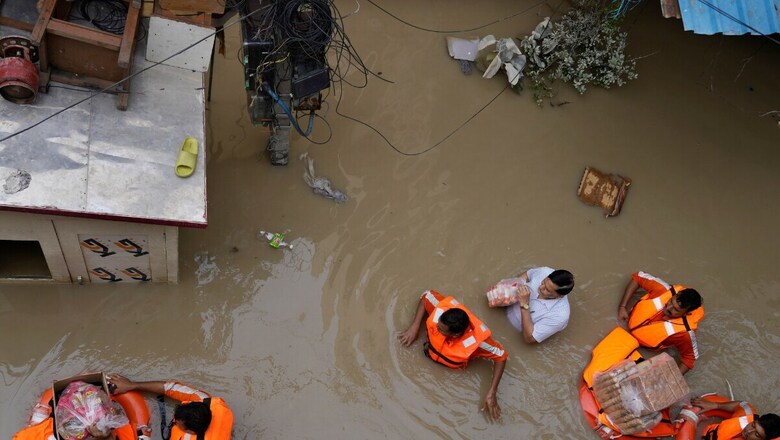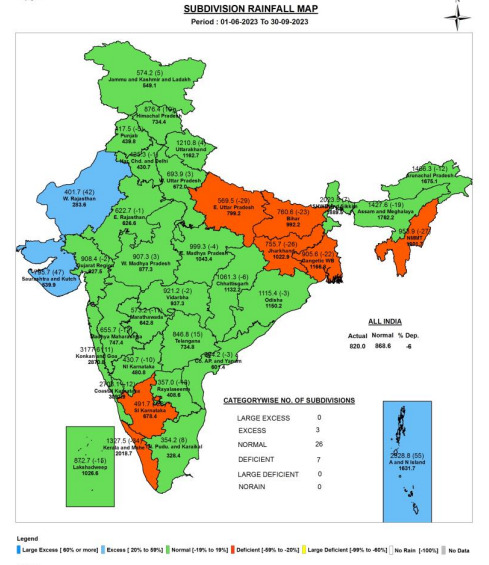
views
Marked by some of the most disastrous floods in recent years, the 2023 monsoon season has ended with below normal rains for the country. According to the India Meteorological Department (IMD), rainfall during the four-month season was 94% of the long period average (LPA).
India’s June to September rainfall is considered normal between 96% and 104% of the LPA, which is basically an average of seasonal rainfall of 50 years from 1971 to 2020, totalling about 870mm. The weather department which had forecasted normal rains at 96% of LPA with +/- 4% says the prediction has augured well as the realised rainfall is 94%, which falls within the lower limit of +/- 4%. However, the country-wide rainfall was just 820 mm with large spatial variations.
There was excess rainfall in two of the geographical regions – North-West India (101% of LPA) and Central India (100% of LPA). Himalayan states Himachal Pradesh and Uttarakhand as well as adjoining Punjab and Haryana were ravaged by floods, with July rains beating the 123-year record.

On the other hand, East and North-East India saw the lowest rainfall at 82% of the LPA, with some parts almost facing drought-like conditions, while it was 92% of the LPA for South India.
18% OF INDIA UNDER SIGNFICANT RAIN-DEFICIT
The life-line of India’s agri-based economy, monsoon provides over 70% of the annual rainfall to the country and is critical for Kharif crops like paddy and cotton, grown from June to October.
Out of the total 36 meteorological subdivisions, as many as seven subdivisions which cover about 18% of the total area received deficient rains. This includes rice-growing states of Gangetic West Bengal, Jharkhand, Bihar, east Uttar Pradesh, as well as south interior Karnataka, Kerala, Nagaland, Manipur, Mizoram and Tripura (NMMT).
The monsoon was excess in three sub-divisions – West Rajasthan, Saurashtra and Kutch, and Andaman & Nicobar Islands. The other 26 sub-divisions comprising 73% of India’s total land saw normal rains.
MONSOON OF EXTREMES BREAKS RECORDS
Despite its late and sluggish onset in June, the monsoon covered the country six days in advance on July 2. It remained below par in June (91%) and August (64%), with India recording its hottest and driest August in nearly 123 years, but it remained vigorous in July and September with 113% excess rains. It was a monsoon of extremes, with devastating floods and long dry breaks.
The season witnessed the highest number of heavy rainfall events in last four years at 2,742. As many as 32 meteorological stations broke their all-time rainfall records with 302 mm in Chandigarh and 224 mm in Ambala on July 9, triggering floods, and 520 mm in Veraval (Gujarat) on July 19. According to scientists, the warming atmosphere can carry more moisture for longer durations, which falls in short bursts and causes heavy rains. Such high intensity rainfall events are set to increase under the impact of climate change.
A total of 14 low pressure systems in the Indian region revved up the monsoon season, most in July (5) and September (5). One of them intensified into an extremely severe cyclonic storm, named Biparjoy, in the Arabian Sea in June.
IMPRINT OF EL NINO
2023 is an El Niño year and its complex interplay with the Indian monsoon rainfall was evident during the season. El Niño is an ocean phenomenon marked by above-normal temperatures in the equatorial Pacific Ocean. While there is no direct co-relation between the two, it is generally linked with below-normal monsoon rains. Weak El Niño conditions had developed in July which became moderate in August and September.
“In this El Niño year, India experienced below-average rainfall. Yet, the presence of the Indian Ocean Dipole (IOD) during the monsoon’s latter phase offset this deficiency, bringing the rainfall anomaly within the standard deviation,” said IMD chief Dr M Mohapatra.
IOD is another system, which, if positive, tends to aid above-normal rains. It remained neutral till the 3rd week of August and became positive thereafter.
MONSOON RETREATING LATER THAN USUAL
The rainy system is now retreating. It began its withdrawal from west Rajasthan on September 25, with a delay of eight days, and is expected to complete the process by October 15.

The latest update suggests it has withdrawn from some parts of Jammu & Kashmir, Himachal Pradesh and Uttarakhand; entire Punjab and Haryana-Chandigarh-Delhi, with conditions becoming favourable for its further withdrawal from remaining parts of North-West India, some more parts of west Madhya Pradesh and Gujarat during the next three to four days.


















Comments
0 comment